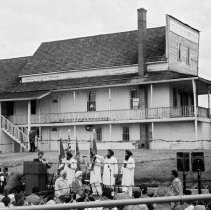Photo Record
Images

Metadata
Catalog Number |
P12554 |
Description |
Ceremony to designate the 1911 Gur Sikh Temple as a National Heritage Site. Sikh moderator and four Sikh musicians on stage with the Temple in the background. Heads of Dignitaries in the foreground. The Gur Sikh Temple is the oldest extant gurdwara in the Western Hemisphere, an anchor for the Sikh community and a symbol of community perseverance and triumph in the face of systematic racist practices that sought to prohibit the establishment of an enduring Sikh community in Canada. The object description lacks the names of members of the Khalsa Diwan Society, Sikh VIPs and other attendees. |
Provenance |
Although still a mainly bachelor society due to discriminatory immigrations laws aimed at stopping the migrants from India, in 1908 the Abbotsford Sikh community decided it was time to build a temple. The gurdwara would provide a place to worship but just as importantly, a place for the community to come together. Sunder Singh Thandi, with Arjan Singh, purchased a one-acre property on a prominent hill adjacent to the mill at Mill Lake. The local millworkers and labourers from farms nearby began construction of the gurdwara. The Trethewey brothers, owners of the mill, donated the lumber for the temple and millworkers carried it to the temple site on their shoulders, working into the night after their shift at the mill. The Abbotsford Post carried advertisements for tenders for steam heating and other specific building tasks. In 1911 the gurdwara was complete for use. The exterior, wood-frame building with a false front and a gabled roof, is typically western architecture, similar to many buildings in many Canadian frontier towns, but still embodies architectural elements important in Sikh traditions and religious beliefs. There are two floors in the temple: the second-floor prayer room housed the sacred text, the Guru Granth Sahib, and provided an open space for worshippers. Doors opened from the prayer hall in all four directions, welcoming all. The lower level housed the langar, where simple, vegetarian meals were prepared daily, and free to all. |
Date |
7/31/2002 |
Object Name |
Print, Photographic |
Source |
Staff Collection |
